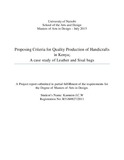| dc.description.abstract | ABSTRACT
Kenya’s commercial handicrafts are produced by small and medium enterprises in the Juakali
sector. Most of the producers in the Juakali sector are operating informally mainly using local
resources, promoting local creativity and skills to produce handicrafts for the local, regional and
global markets. In Kenya, the quality of the handicrafts created is diverse among the producers
and consumers. Handicraft producers in Asia, example the Philippines are seen as respectable
contributors of foreign exchange in their economies. The Philippines handicraft industry has the
support of national institutions that are formed to assist the various producers. Through this
guidance, Philippine handicrafts are identified and accepted globally among the high-end
markets. The research looked at the Philippines handicraft situation as an ideal example where
handicraft sales were thriving. In Kenya although the country has a thriving handicraft sector, the
supporting institutions are not consolidated and clearly defined in their roles to the handicraft
sector. This research focused on collecting information on the quality of handicrafts in Kenya. It
looked at the set standards required for handicrafts to be more competitive in the global markets.
The researcher identified three handicraft producer groups as the sample for this research. This
was a qualitative study and data was collected through participant and non-participant
observation, structured and semi structured interviews and focus group discussions. Data
analysis and presentation was descriptive. From the data collected, the production of quality
handicrafts in Kenya was seen to be varied among the producers. A nationally recognised
criterion that identifies the quality of the handicrafts was lacking. An ideal production process
with the key criteria checklist is proposed to guide in the production of quality handicraft
products. With better quality handicraft products, producers would increase their earnings and
there would be economic growth countrywide.
KEY WORDS:artisans, design process, handicrafts, product attributes, production process,
quality, standards. | |

